Sculptures and Accessories: Domestic Piety in the Norwegian Parish around 1300
Abstract
:1. Introduction
2. Crucifixes and Crosses in Medieval Norway
3. Medieval Devotion to the Cross
4. Arm Ring Symbolism and Miracle Working Crosses in Old Norse Texts
The Holy Cross is a shield for all danger, support for all misery, in sorrow it is a comfort and in joy an encouragement for the good; it is protection from danger, healing from ailment liberation from all ties, counsel from sin, victory in battle, strength against temptation, powerful for the poor and a chieftain for the powerful (stjórn auðigra) (…). All this is due to God’s mercy, for the one who on the Cross redeemed mankind from death—Jesus Christ. Him be praised with the Father and the Holy Spirit per omnia saecula saeculorum amen.(Gammelnorsk homiliebok, 109)
5. Silver Bracelets—Devotion, Gifts and Gender
This would I have done: I would be borne to Skalaholt if I die of this sickness, because my mind tells me that that stead will be for one while the most worshipped stead in the land; and I wot also,” says she, “that there will be priests to do the singing over me; so I pray thee to bring me there, and of my goods shalt thou [Thorod] have so much as that thou wilt have no loss thereby; but from my undivided goods shall Thurid have the scarlet cloak that I own; and this I do to the end that she may be content that I see to my other goods in such wise as I will; but I will that thou take for the cost thou hast for me that which thou wilt, or that pleases her, from such things alone as I leave thereto. A gold ring I have which shall go to church with me, but I will that my bed and my bed-hangings be burned up with fire, for that they will be of no good to any man; and I say this not because I grudge anyone to enjoy those good things, if I knew that they would be of good avail to any; but now I say so much thereover,” says she, “because I deem it ill that folk should have so much heavy trouble from me, as well I wot will be, if ye turn away from that which I now ordain.”(Eyrbyggja saga, chapter 51)
6. Concluding Remarks
Funding
Acknowledgments
Conflicts of Interest
References
Primary Sources
Diplomatarium Islandicum. 1857–1976. Reykjavik and Copenhagen: Hið íslenska bókmenntafélag. https://baekur.is/search.Diplomatarium Norvegicum. 1847–2011. Oslo: Riksarkivet. https://www.dokpro.uio.no/dipl_norv/diplom_felt.html.Fagrskinna: A Catalogue of the Kings of Norway. 2004. Translation and introduction by Alison Finlay. Leiden: Brill.Gammelnorsk homiliebok. 1972. Translation by Astrid Salvesen and introduction and comments by Erik Gunnes. Oslo: Universitetsforlaget.Leiðarvísir, an Old Norse itinerarium: A Proposal for a New Partial Translation and Some Notes about the Place-Names. Translation and Comments by Luana Giampiccolo. https://skemman.is/bitstream/1946/14573/1/Lei%C3%B0arv%C3%ADsir.pdf.Grettir’s saga. 1900. Translated by William Morris and Eirikr Magnusson. https://sagadb.org/grettis_saga.en.Hamar-krøniken med andre kilder til kunnskap om det gamle Bispesete ved Mjøsen. 1937. Published by Arne Arnesen. Oslo: Foreningen for Norsk Bokkunst.Magnússona saga. 2015. In Snorri Sturluson. Heimskringla, Vol. III. Translated by Alison Finlay and Anthony Faulkes. London: University College London, pp. 147–69.Magnúss saga blinda ok Haralds gilla. 2015. In Snorri Sturluson. Heimskringla, Vol. III. Translated by Alison Finlay and Anthony Faulkes. London: University College London, pp. 170–86.Páls biskups saga. 1858. In Biskupa sögur. Vol. 1. Copenhagen: Hið íslenska bókmenntafélag, pp. 125–48.Eyrbyggja saga. 1989. Translated by Hermann Pálsson and Paul Edwards. Harmondsworth: Penguin Classics.Symbolae ad geographiam medii aevi, ex monumentis islandicis. 1832. Publication, introduction and comments by Erik Christian Werlauff. Copenhagen: Gyldendal.Secondary Sources
- Algazi, Gadi, Valentin Groebner, and Bernhard Jussen. 2003. Negotiating the Gift: Pre-Modern Figurations of Exchange. Göttingen: Vandenhoeck and Ruprecht. [Google Scholar]
- Andersson, Catharina. 2010. Andliga gåvor i världsligt bruk—Om den religiösa gåvan som social och maktskapande handling [Spiritual gifts in secular contexts—About the religious gift as social and powerful act]. In Gaver, Ritualer, Konflikter. Et Rettsantropologisk Perspektiv på Nordisk Middelalderhistorie [Gifts, Rituals, Conflicts. An Anthropological Perspective on Nordic Medieval History]. Edited by Hans Jacob Orning, Kim Esmark and Lars Hermansson. Bergen: Fagbokforlaget, pp. 39–75. [Google Scholar]
- Bagge, Sverre. 1998. Mennesket i middelalderens Norge: Tanker, tro og Holdninger 1000–1300 [People in medieval Norway: Thoughts, belief and attitudes 1000–1300]. Oslo: Aschehoug. [Google Scholar]
- Bagge, Sverre. 2010. From Viking Stronghold to Christian Kingdom. State Formation in Norway, c. 900–1350. Copenhagen: Museum Tusculanums Forlag. [Google Scholar]
- Belting, Hans. 1981. Das Bild un sein Publikum. Form und Funktion früher Bildtafeln der Passion [Likeness and Presence: A History of the Image before the Era of Art]. Berlin: Mann Verlag. [Google Scholar]
- Blick, Sarah. 2019. Bringing Pilgrimage Home: The Production, Iconography, and Domestic Use of Late-Medieval Devotional Objects by Ordinary People. Religions 10: 392. [Google Scholar] [CrossRef]
- Blindheim, Martin. 1986. Skandinaviske krusifiks med verdighetstegn [Scandinavian crucifixes with insignia]. In Festskrift til Martin Blindheim [Tributes to Martin Blindheim]. Edited by Irmelin Martens, Bjørn Myhre, Eldrid Straume, Per Jonas Nordhagen and Erla Hohler. Oslo: Universitetets Oldsaksamling. [Google Scholar]
- Blindheim, Martin. 1998. Painted Wooden Sculpture in Norway c.1100–1250. Oslo: Scandinavian University Press. [Google Scholar]
- Blindheim, Martin. 2004a. Gothic Painted Wooden Sculpture in Norway 1220–1350. Oslo: Messel forlag. [Google Scholar]
- Blindheim, Martin. 2004b. The Cult of Medieval Wooden Sculptures in Post-Reformation Norway. In Images of Cult and Devotion: Function and Reception of Images in Medieval and Post-Medieval Europe. Edited by Søren Kaspersen and Ulla Hastrup. Copenhagen: Museum Tusculanum Press, pp. 47–59. [Google Scholar]
- Bondevik, Kjell. 1935. Valfarting og lovnader [Pilgrimage and promises]. In Museet i Haugesund: 10 års melding 1925–1935 og avhandlinger om vest-norsk kultur [Haugesund Museum: A Report after 10 Years 1925-1935 and Essays on the Culture of Western Norway]. Edited by Heming Skre, C. Magne Rønnevik and John A. Døsseland. Bergen: John Griegs boktrykkeri, pp. 65–77. [Google Scholar]
- Brendalsmo, Jan, Tine Frøysaker, and Jørgen H. Jensenius. 2001. Kors og krusifiks: tre utsnitt av deres historie [Crosses and crucifixes: three aspects of their history]. Oslo: NIKU. [Google Scholar]
- Brundin, Abigail, Deborah Howard, and Mary Laven. 2018. The Sacred Home in Renaissance Italy. Oxford: Oxford University Press. [Google Scholar]
- Bynum, Caroline Walker. 1988. Holy Feast and Holy Fast: The Religious Significance of Food to Medieval Women. Oakland: University of California Press. [Google Scholar]
- Bynum, Caroline Walker. 2011. Christian Materiality: An Essay on Religion in Late Medieval Europe. New York: Zone Books. [Google Scholar]
- Carruthers, Mary. 2013. The Experience of Beauty in the Middle Ages. Oxford: Oxford University Press. [Google Scholar]
- Catto, Jeremy. 2000. Currents of Religious Thought and Expression. In The New Cambridge Medieval History. Volume VI c.1300–1415. Edited by Michael Jones. Cambridge: Cambridge University Press, pp. 42–65. [Google Scholar]
- Corry, Mary, Marco Faini, and Alessia Meneghin. 2018. Domestic Devotions in Early Modern Italy. Leiden: Brill. [Google Scholar]
- Dekoninck, Ralph. 2012. Between denial and exaltation: The materials of the miraculous images of the Virgin in the Southern Netherlands during the seventeenth century. In Meaning in Materials, 1400–1800 (Netherlandish Yearbook for Art History 62). Edited by Ann-Sophie Lehmann, Frits Scholten and H. Perry Chapman. Leiden and Boston: Brill, pp. 148–75. [Google Scholar]
- Duffy, Eamon. 1992. The Stripping of the Altars: Traditional Religion in England 1400–1580. New Haven and London: Yale University Press. [Google Scholar]
- Emanuelsson, Anders. 2005. Kyrkojorden och dess Ursprung. Oslo Biskopsdöme Perioden ca. 1000–ca. 1400 [The Church Land and its Origin: Oslo Bishopric c.1000-c.1400]. Göteborg: Göteborgs universitet. [Google Scholar]
- Fisher, Annika Elisabeth. 2006. Cross Altar and Crucifix in Ottonian Cologne: Past Narrative, Present Ritual, Future Resurrection. In Decorating the Lord’s Table: On the Dynamics between Image and Altar in the Middle Ages. Edited by Søren Kaspersen and Erik Thunø. Copenhagen: Museum Tusculanum Press, pp. 43–62. [Google Scholar]
- Freedberg, David. 1989. The Power of Images: Studies in the History and Theory of Response. Chicago and London: The University of Chicago Press. [Google Scholar]
- French, Katherine L. 2008. The Good Women of the Parish: Gender and Religion after the Black Death. Philadelphia: University of Pennsylvania Press. [Google Scholar]
- Fuglesang, Signe Horn, and David Wilson. 2006. The Hoen Hoard: A Viking Gold Treasure of the Ninth-Century. Rome: Bardi Editore. [Google Scholar]
- Gell, Alfred. 1998. Art and Agency: An Anthropological Theory. Oxford: Clarendon. [Google Scholar]
- Genovese, Valeria. 2011. Statue vestite e snodate. Un percorso [The Dressing and Undressing of Statues. An Outline]. Pisa: Edizione della Normale. [Google Scholar]
- Gilchrist, Roberta. 2012. Medieval Life: Archaeology and the Life Course. London: Boydell Press. [Google Scholar]
- Gilchrist, Roberta. 2013. The Materiality of Medieval Heirlooms: From biographical to sacred objects. In Mobility, Meaning and Transformations of Things: Shifting Contexts of Material Culture through Time and Space. Edited by Hans Peter Hahn and Hadas Weis. Oxford and Oakvill: Oxbow Books, pp. 170–82. [Google Scholar]
- Gjerløw, Lilli. 1970. Missaler brukt i Bjørgvin bispedømme fra misjonstiden til Nidarosordinariet [Missals used in Bjørgvin bishopric from the time of missionaries to the Nidaross ordinarium]. In Bjørgvin bispestol: Byen og bispedømmet [Bjørgvin: The City and the Bishopric]. Edited by Per Juvkam. Bergen: Universitetsforlaget, pp. 73–115. [Google Scholar]
- Golsenne, Thomas. 2010. Parure et culte [Orament and cult]. In La Performance des Images [The Performance of Images]. Edited by Alain Dierkens, Gil Bartholeyns and Thomas Golsenne. Brussels: Éditions de l’université de Bruxelles, pp. 71–84. [Google Scholar]
- Glørstad, Zanette T., and Camilla C. Wenn. 2017. A view from the valley: Langeid in Setesdal, South Norway—A Viking Age trade station along a mercantile highway. In Viking-Age Transformations: Trade, Craft and Resources in Western Scandinavia. Edited by Zanette T. Glørstad and Kjetil Loftsgarden. London: Routledge, pp. 191–211. [Google Scholar]
- Helander, Sven. 2001. The liturgical profile of the parish church in medieval Sweden. In The Liturgy of the Medieval Church. Edited by Thomas J. Heffernan and E. Ann Matter. Kalamazoo: Michigan University Press, pp. 146–86. [Google Scholar]
- Hohler, Erla Bergendahl. 1994. Borre-korset [The Holy Cross from Borre]. In Fra hammer til kors: 1000 år med kristendom. Brytningstid i Viken [From Hammer to Cross: 1000 Years of Christianity. Transitional Times in Viken]. Edited by Knut B. Bjerva and Jan Ingar Hansen. Oslo: Schibsted, pp. 173–82. [Google Scholar]
- Hoff, Anne Marta. 1997. Holdhus kyrkje. In Norges kirker: Hordaland [Churches in Norway: Hordaland]. Edited by Hans Emil Lidén, Anne Marta Hoff and Ola Storsletten. Oslo: Land og kirke, Volume 2, pp. 8–24. [Google Scholar]
- Holloway, Julia Bolton. 1984. The Dream of the Rood and Liturgical Drama. Comparative Drama 18: 19–37. [Google Scholar] [CrossRef]
- Howell, Martha C. 1996. Fixing Movables: Gifts by Testament in Late Medieval Douai. Past and Present 150: 3–45. [Google Scholar] [CrossRef]
- Jernæs, Nina Kjølsen. 2016. Tre middelalderskulpturer fra A 265 Gjerstad kirke. Undersøkelse og behandling av et krusifiks og to helgenskulpturer [Three Medieval Sculptures from A 265 Gjerstad Church. Examination and Treatment of one Crucifix and Two Saints]. Oslo: NIKU. [Google Scholar]
- Jürgensen, Martin Wangsgaard. 2018. Ritual and Art across the Danish Reformation: Changing Interiors of Village Churches 1450–1600. Turnhout: Brepols. [Google Scholar]
- Jørgensen, Ellen. 1909. Helgendyrkelse i Danmark: Studie over kirkekultur og kirkeligt liv fra det 11te aarhundredes midte til Reformationen [Veneration of Saints in Denmark. Essays in Culture and Religious Life from the Mid-11th Century to the Reformation]. Copenhagen: H. Hagerups Forlag. [Google Scholar]
- Kamerick, Kathleen. 2002. Popular Piety and Art in the Late Middle Ages: Image Worship and Idolatry in England 1300–1500. London: Palgrave. [Google Scholar]
- Kaspersen, Søren, and Ulla Hastrup. 2004. Images of Cult and Devotion: Function and Reception of Images in Medieval and Post-Medieval Europe. Copenhagen: Museum Tusculanum Press. [Google Scholar]
- Keane, Marguerite. 2016. Material Culture and Queenship in 14th-century France: The Testament of Blanche of Navarre (1331–1398). Leiden: Brill. [Google Scholar]
- Kirby, Jo, Susie Nash, and Joanna Cannon. 2010. Trade in Artists’ Materials: Markets and Commerce in Europe to 1700. London: Archetype. [Google Scholar]
- Kopania, Kamil. 2010. Animated Sculptures of the Crucified Christ in the Religious Culture of the Latin Middle Ages. Warsaw: Neriton. [Google Scholar]
- Kroesen, Justin, Micha Leeflang, and Marc Sureda i Jubany. 2019. North & South. Medieval Art from Norway and Catalonia 1100–1350. Zwolle: WBOOKS. [Google Scholar]
- Karker, Allan, Helge Pohjolan-Pirhonen, Magnús Már Lárusson, Finn Hødnebø, and John Granlund, eds. 1956–1978. Kulturhistorisk leksikon for nordisk middelalder (KLNM) [Lexicon of the Cultural History of the Nordis Middle Ages]. Copenhagen: Rosenkilde and Bagger. [Google Scholar]
- Kurz, Herbert. 1997. Der Volto Santo von Lucca: Ikonographie und Funktion des Kruzifixus in der gegürteten Tunika im 11. Jahrhundert [The Volto Santo from Lucca. Iconography and Function of the Crucifix with Belt and Tunic in the 11th Century]. Regensburg: Roderer Verlag. [Google Scholar]
- Laugerud, Henning, Salvador Ryan, and Laura Katrine Skinnebach. 2016. The Materiality of Devotion in Late Medieval Northern Europe: Images, Objects and Practices. Dublin: Four Courts Press. [Google Scholar]
- Lohfert Jørgensen, Hans Henrik. 2017. Live Matter and Living Images: Towards a Theory of Animation in Material Media. Konsthistorisk Tidsskrift 86: 251–70. [Google Scholar] [CrossRef]
- Lund, Julie. 2017. Connectedness with things. Animated objects of Viking Age Scandinavia and early medieval Europe. Archaeological Dialogues 24: 89–108. [Google Scholar] [CrossRef]
- Hall, Mark A. 2011. The Cult of Saints in Medieval Perth: Everyday Ritual and the Materiality of Belief. Journal of Material Culture 16: 80–104. [Google Scholar] [CrossRef]
- Marks, Richard. 2004. Image and Devotion in Late Medieval England. London: Sutton. [Google Scholar]
- Martinelli, Stefano. 2016. L’immagine del Volto Santo di Lucca. Il successo europeo di un’iconografia medievale [The Image of the Volto Santo from Lucca. The European Success of a Medieval Iconography]. Pisa: Edizioni ETS. [Google Scholar]
- Matyjaszkiewicz, Ika. 2018. Distance and Embrace: Spatial Conditions of Access to the Volto Santo of Lucca. In Place and Space in the Medieval World. Edited by Meg Boulton, Jane Hawkes and Heidi Stoner. London: Routledge (e-book). [Google Scholar]
- Mauss, Marcel. 1923. Essai sur le don [Essay on the Gift]. In L’Année sociologique [Yearbook of Sociology]. Edited by Émile Durkheim. Paris: Alcan, pp. 30–186. [Google Scholar]
- Ó Carragáin, Éamonn. 2005. Ritual and the Rood: Liturgical Images and the Old English Poems of the Dream of the Rood Tradition. London: The British Library and Toronto: University of Toronto Press. [Google Scholar]
- Van Os, Henk, Eugène Honoré, Hans Niewdorp, and Bernard Ridderbos. 1994. The Art of Devotion in the Late Middle Ages in Europe, 1300–1500. Princeton: Princeton University Press. [Google Scholar]
- Palsson, Vidar. 2010. Power and Political Communication. Feasting and Gift Giving in Medieval Iceland. Ph.D. dissertation, University of California, Berkeley, CA, USA. [Google Scholar]
- Pongratz-Leisten, Beate, and Karen Sonik. 2015. The Materiality of Divine Agency. Boston and Berlin: De Gruyter. [Google Scholar]
- Ringbom, Sixten. 1984. Icon to Narrative: The Rise of the Dramatic Close-Up in Fifteenth-Century Devotional Painting. Doornspijk: Davaco. [Google Scholar]
- Rosler, Martha, Caroline Walker Bynum, Natasha Eaton, Michael Ann Holly, Amelia Jones, Michael Kelly, Robin Kelsey, Alisa LaGamma, Monika Wagner, Oliver Watson, and et al. 2013. Notes from the Field: Materiality. The Art Bulletin 95: 10–37. [Google Scholar] [CrossRef]
- Rubin, Miri. 1991. Corpus Christi: The Eucharist in Late Medieval Culture. Cambridge: Cambridge University Press. [Google Scholar]
- Schmitt, Jean Claude. 1995. Cendrillon crucifiée. À propos du Volto santo de Lucqus [The Crucified Cinderella. Some Thoughts on the Volto Santo from Lucca]. In Miracles, Prodiges et Merveilles au Moyen Âge, Actes du XXVe Congrès de la S.H.M.E.S, Orléans, Juin 1994 [Miracles, Prodigies and Wonders in the Middle Ages. Proceedings from the 25th Congress of the S.H.M.E.S. in Orleans, June 1994]. Paris: Publications de la Sorbonne, pp. 241–69. [Google Scholar]
- Skinnebach, Laura Katrine, and Henning Laugerud. 2007. Instruments of Devotion: The Practices and Objects of Religious Piety from the Late Middle Ages to the 20th Century. Aarhus: Aarhus Universitetsforlag. [Google Scholar]
- Smail, Daniel Lord. 2016. Law and the Uncertainty of Value in Late Medieval Marseille and Lucca. In The Dark Side of Knowledge: Histories of Ignorance, 1400 to 1800. Edited by Cornel Zwierlein. Leiden: Brill, pp. 51–69. [Google Scholar]
- Smith, Mary Francis, Robin Fleming, and Patricia Halpin. 2001. Court Piety in Anglo-Saxon England. The Catholic Historical Review 87: 569–602. [Google Scholar] [CrossRef]
- Staecker, Jörn. 1999. Rex Regum et Dominus Dominorum: Die wikingerzeitlichen Kreutz- und Kruzifixanhänger als Ausdruck der Mission in Altdänemark und Schweden [Rex Regnun et Dominus Dominorum: The Cross- and Crucifix Pendants of the Vikings as Missionary Symbols in Old Denmark and Sweden]. Stockholm: Almqvist and Wiksell. [Google Scholar]
- Staecker, Jörn. 2006. The Cross Goes North: Christian Symbols and Scandinavian Women. In The Cross Goes North: Processes of Conversion in Northern Europe, AD 300–1300. Edited by Martin Carver. Woodbridge: Boydell Press, pp. 463–82. [Google Scholar]
- Stang, Margrethe C. 2015. Bildedonasjoner og donatorbilder. Lekfolks gaver til kirken som visuell kultur [Image Donations and Donator Images. Lay People’s Gifts to the Church as Visual Culture]. Collegium Medievale 28: 145–62. [Google Scholar]
- Trexler, Richard C. 1991. Habiller et déshabiller les images, esquisse d’une analyse [Dressing and Undressing Images, an Analytical Sketch]. In L’image et la Production du Sacré [The Image and the Production of the Sacred]. Edited by François Dunand, Jean-Michel Spieser and Jean Wirth. Pairs: Méridiens Klincksieck, pp. 195–231. [Google Scholar]
- Tripps, Johannes. 2000. Das Handelnde Bildwerk in der Gotik [The Acting Image in the Gothic Period]. Berlin: Gebrüder Mann Verlag. [Google Scholar]
- Il Volto Santo. 2003. La Santa Croce di Lucca: il Volto Santo: Storia, Tradizioni, Immagini. Atti del Convegno, Villa Bottini 1–3 Marzo 2001 [The Holy Cross from Lucca: the Volto Santo. History, Traditions, Images. Proceedings from Villa Bottini 1–3 March 2001]. Edited by Marzia Zingoni. Empoli: Editori dell’Acero. [Google Scholar]
- Weiner, Annette. 1992. Inalienable Possessions: The Paradox of Keeping-While-Giving. Berkeley: University of California Press. [Google Scholar]
| 1 | Ræflum/refil is a rectangular, horizontally cut textile often with iconographical motifs; tioldum/tjeld are textiles hang on the wall in larger pieces. |
| 2 | “Jtem æin kross stor cum mari et Johanne med sex silfr spongum þriar vm huarn arm ok [æ]in silfr sylgia” and “Jtem æinn kross klædr med ok pæll tuæimr silfr spongum vm mitt ok vi vm armanna.” |
| 3 | Eight öre but one örtug. Öre = 1/8 mark and örtug = 1/24 mark. In 1287, one mark = 214.3 g, cf. Nils Ludvig Rasmussen, “Mark” in Kulturhistorisk leksikon for nordisk middelalder (KLNM) Vol.11:424 and Swen Owe Jansson, “Vikt” in KLNM, Vol. 20: 58 (Karker et al. 1956–1978). |
| 4 | Pellz/pell probably refers to silk fabrics; camelot refers to a woven fabric that might have originally been made of camel or goat’s hair, and fustane is a fabric made of cotton. |
| 5 | Apart from the two crucifixes in Hamar and Røldal and the Borre cross, there is also a cavity on top of the head and incised tear channels in the figure of St Anne in the late medieval imported sculpture group of Virgin and Child with St Anne (c.1520, of unknown original display, now preserved at the Museum of Cultural Heritage, Oslo), betraying agencies similar to the ones ascribed to the crucifix from Hamar. This perceived animation, however obviously post-date the kinds of devotional activities considered for this essay. |
| 6 | Post-dating the inventories, two entries from the Icelandic diploma allows us to identify two crucifixes in the church of St Mary at Alftanes, «one cross dressed and one undressed» (1354) and one in Vallanes which was fitted with a suitable chasuble and amictus (1448). |
| 7 | Dagför or Lunu til Luku; þar er Biskopsstoll at Mario kirkiu [i.e., San Martino], þar er roda su er Nichodemus let gera eptir Gudi sialfum; hon hefir ii. sinnum mælt, annat sinn gaf hon sko sin aumun manni, enn annat sinn bar hon vitni rægdum mann. |
| 8 | Hann Eirikr Danakonungr Sveinsson lagdi fé til i Luku, at, hverr madr skylldi drecka vin okeypiss…einu af danski tunugu ok hann let gera spital viii milum sudr fra Plazinzoborg. |
| 9 | “Men boin tissut pour caindre de ymagène Notre-Dame di Tournay.” |
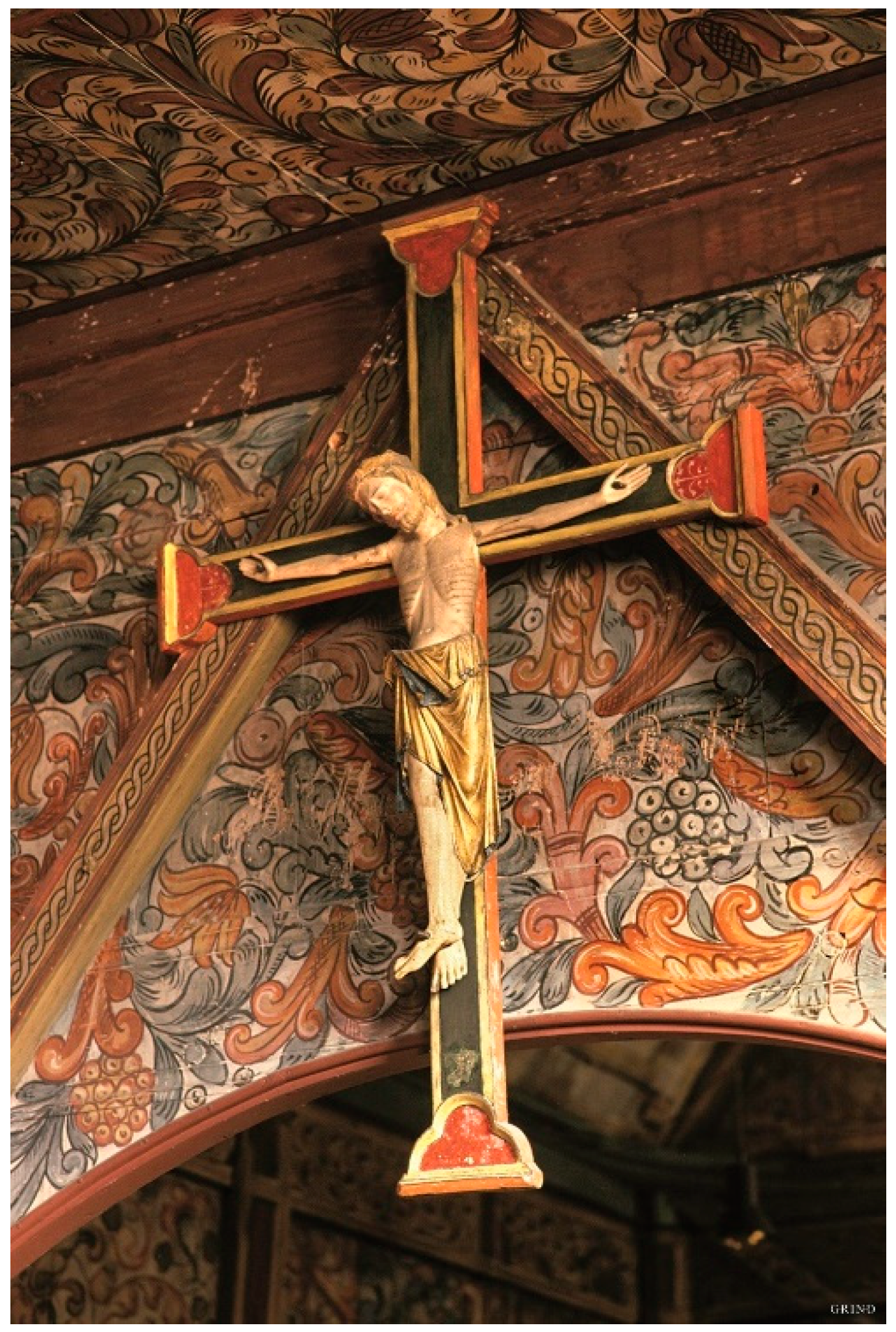
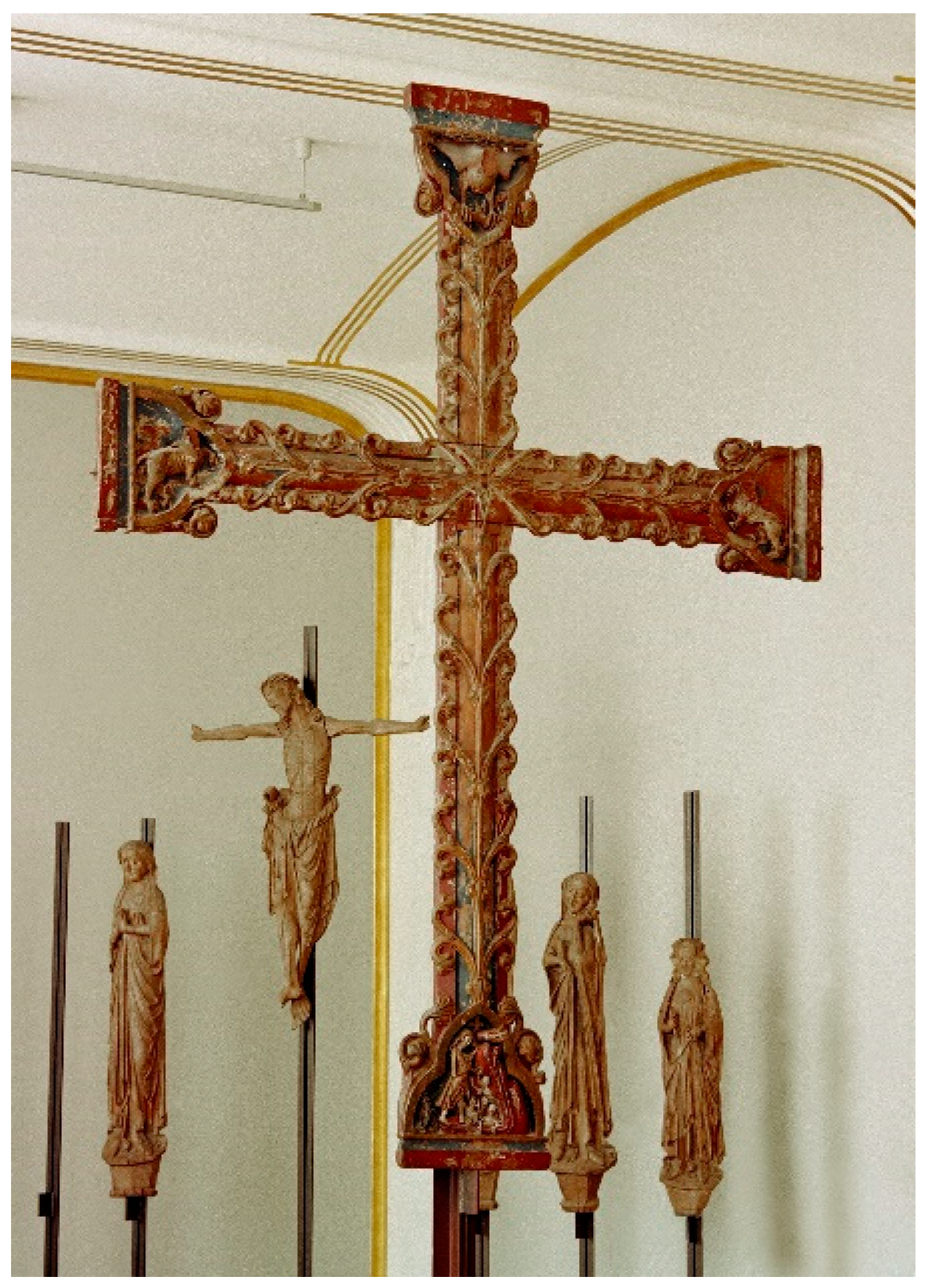
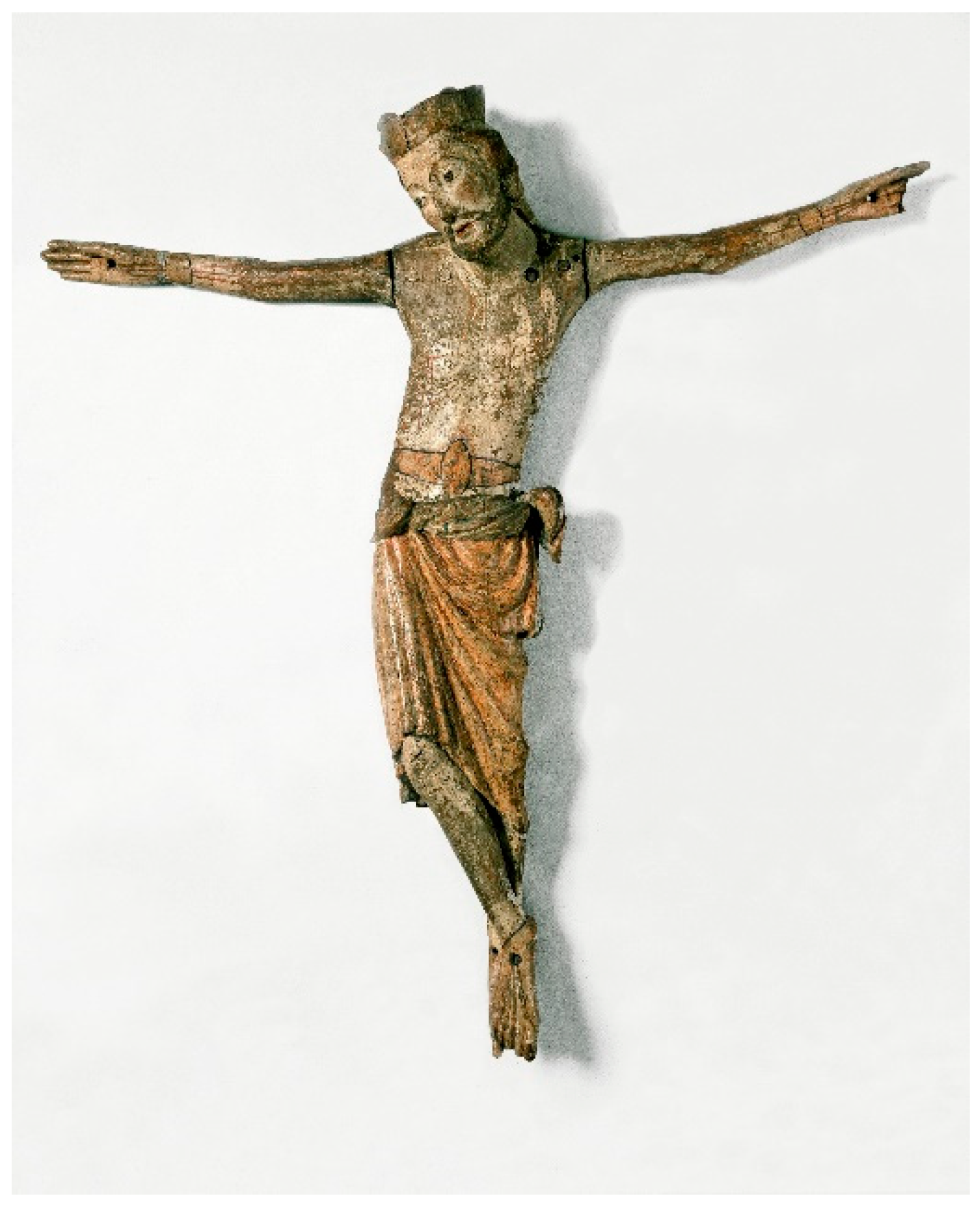
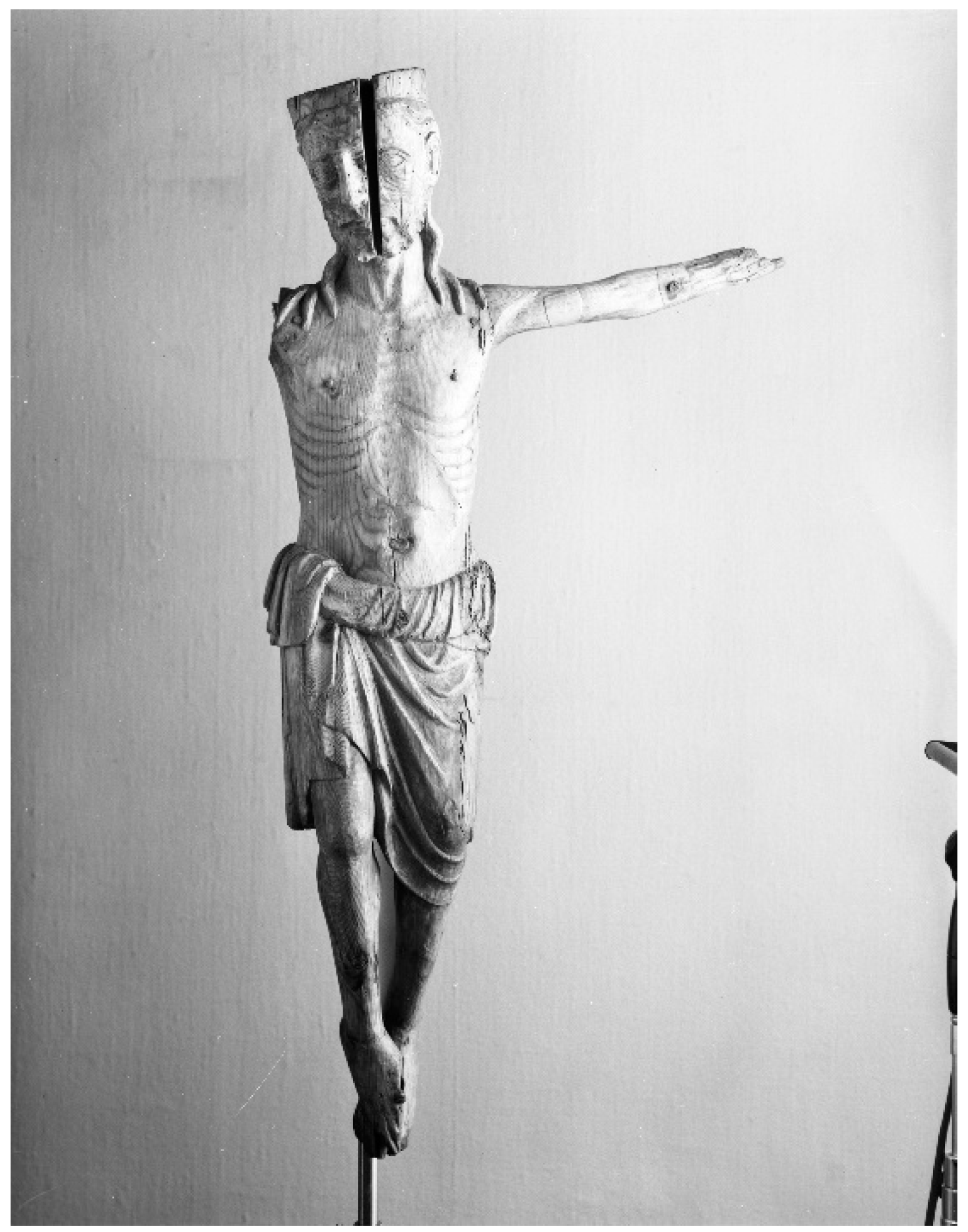
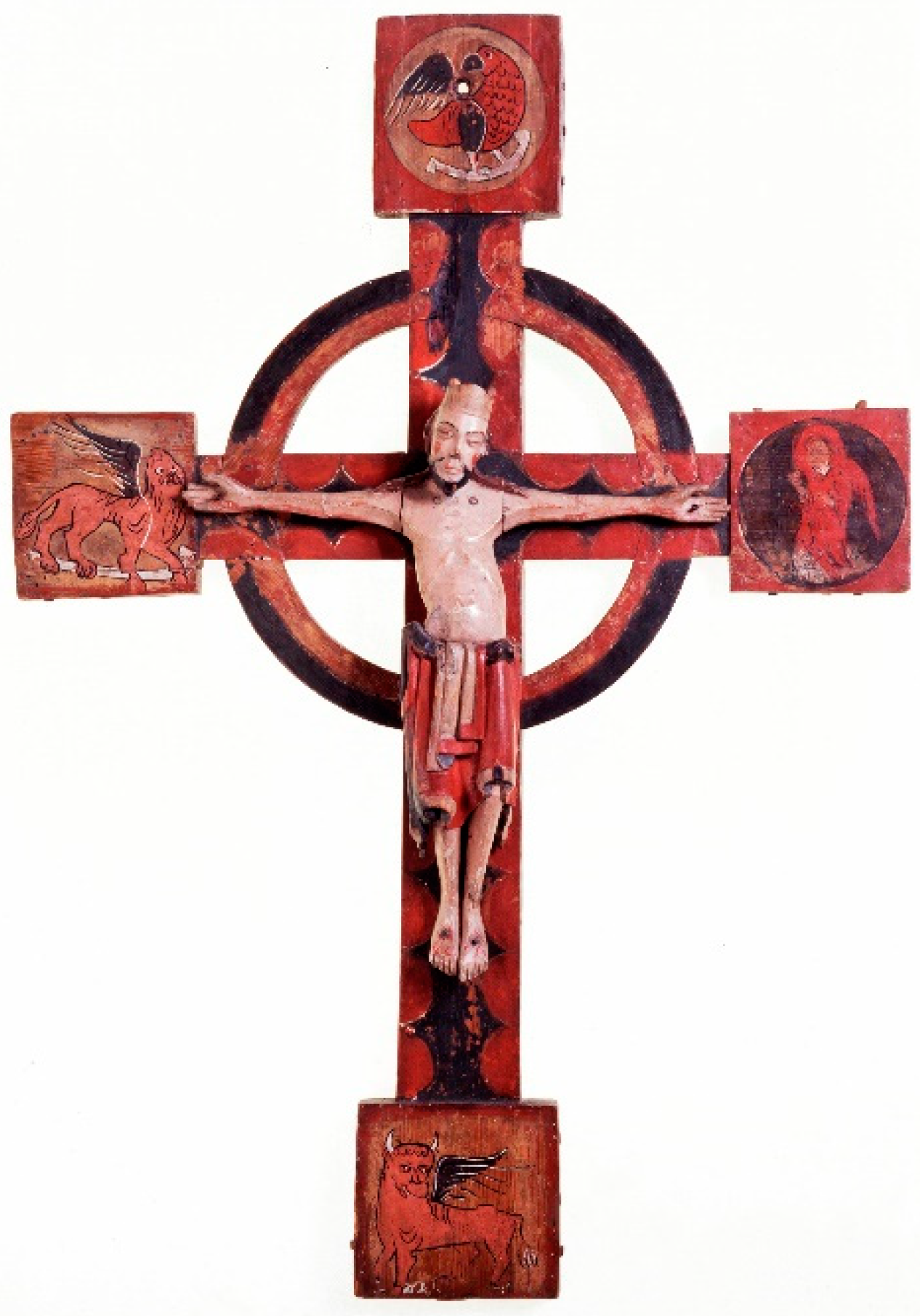


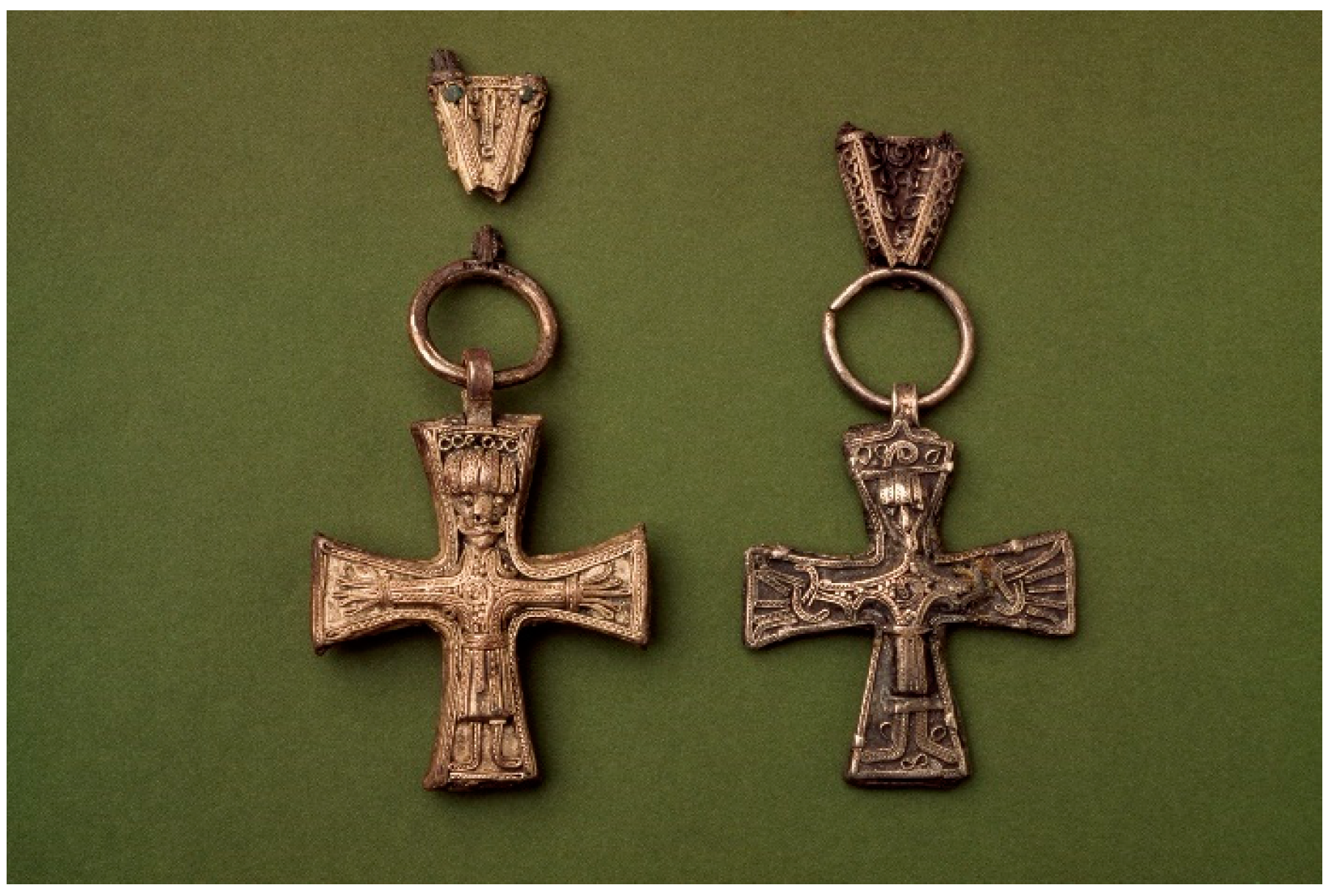
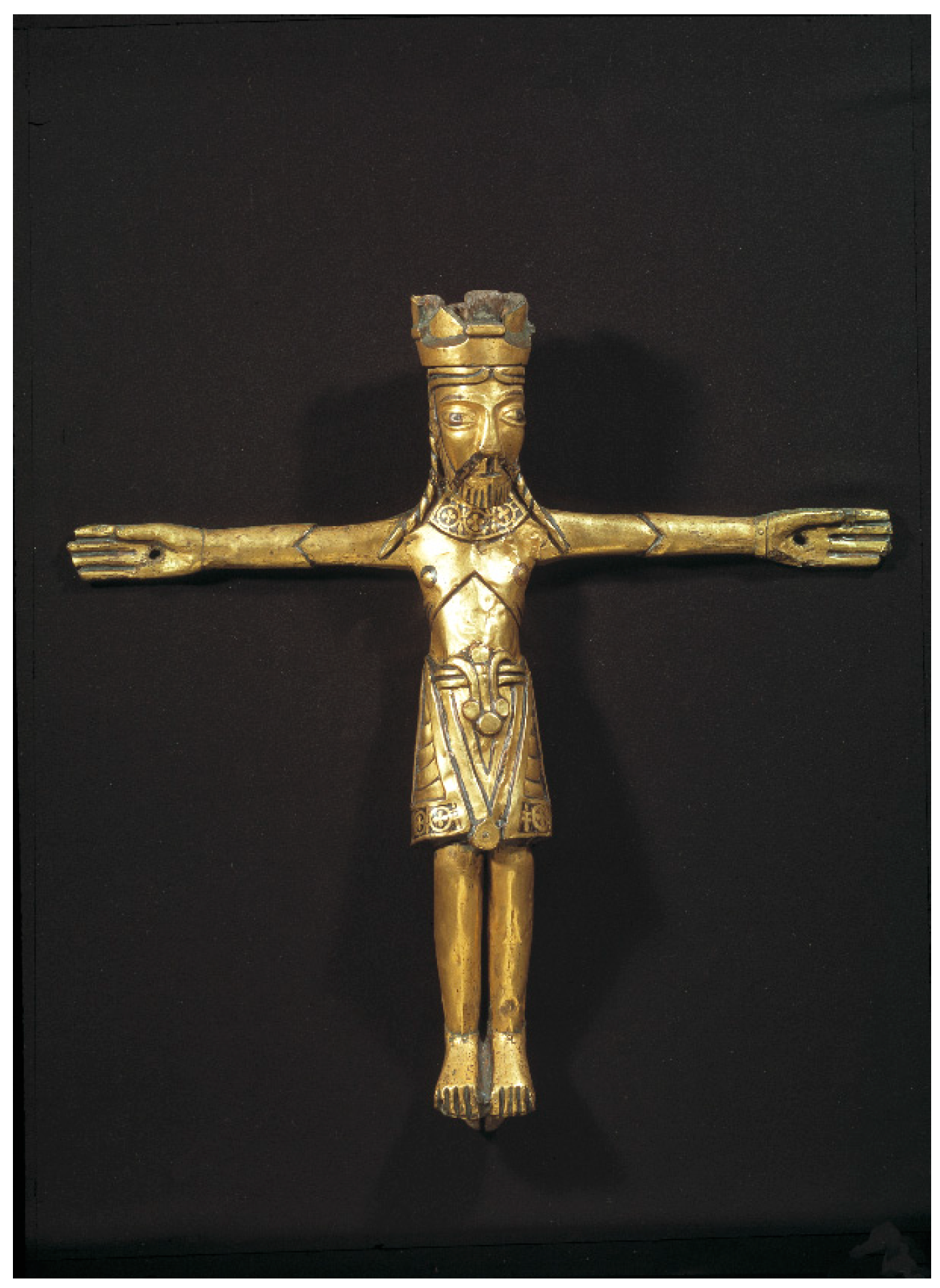
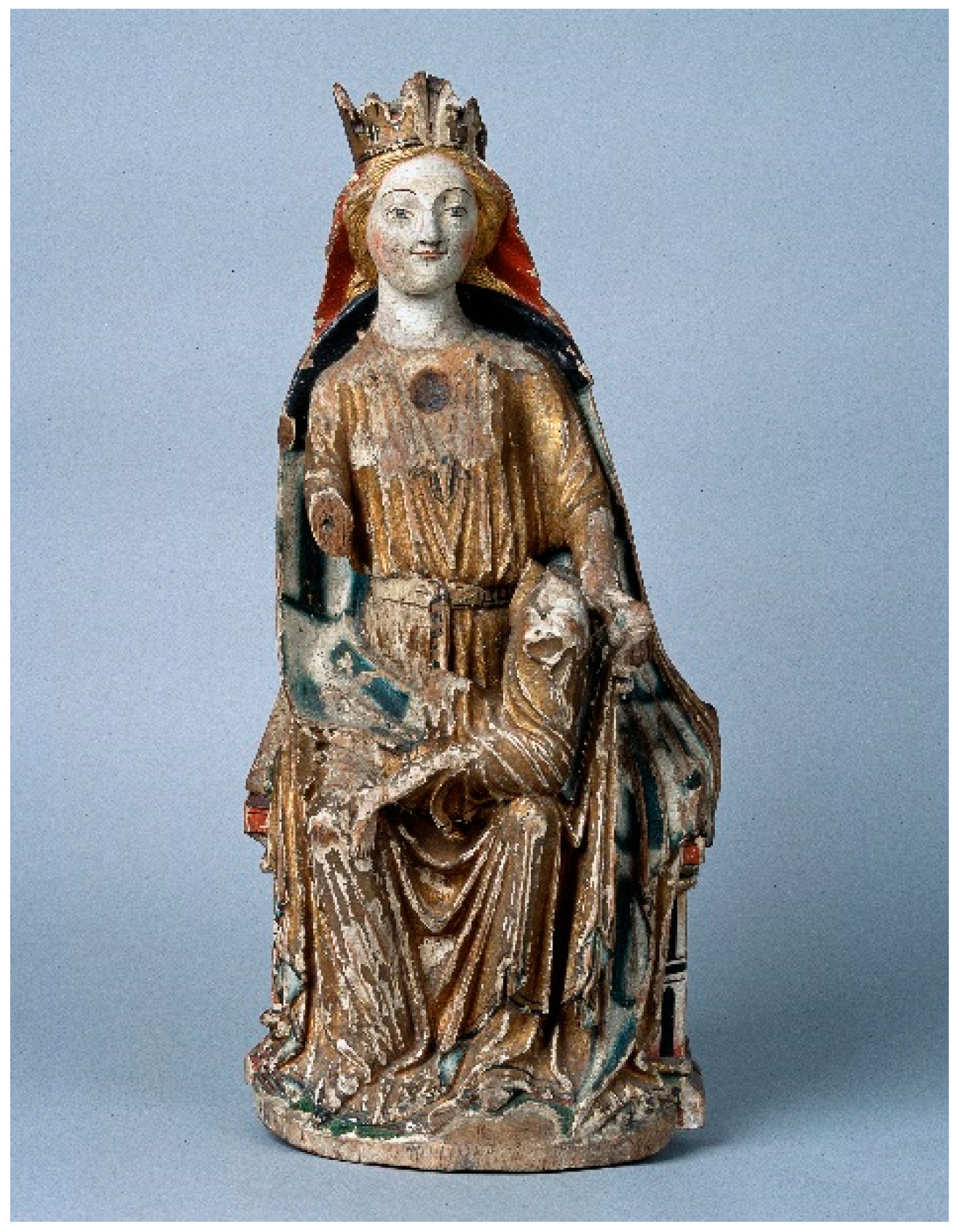
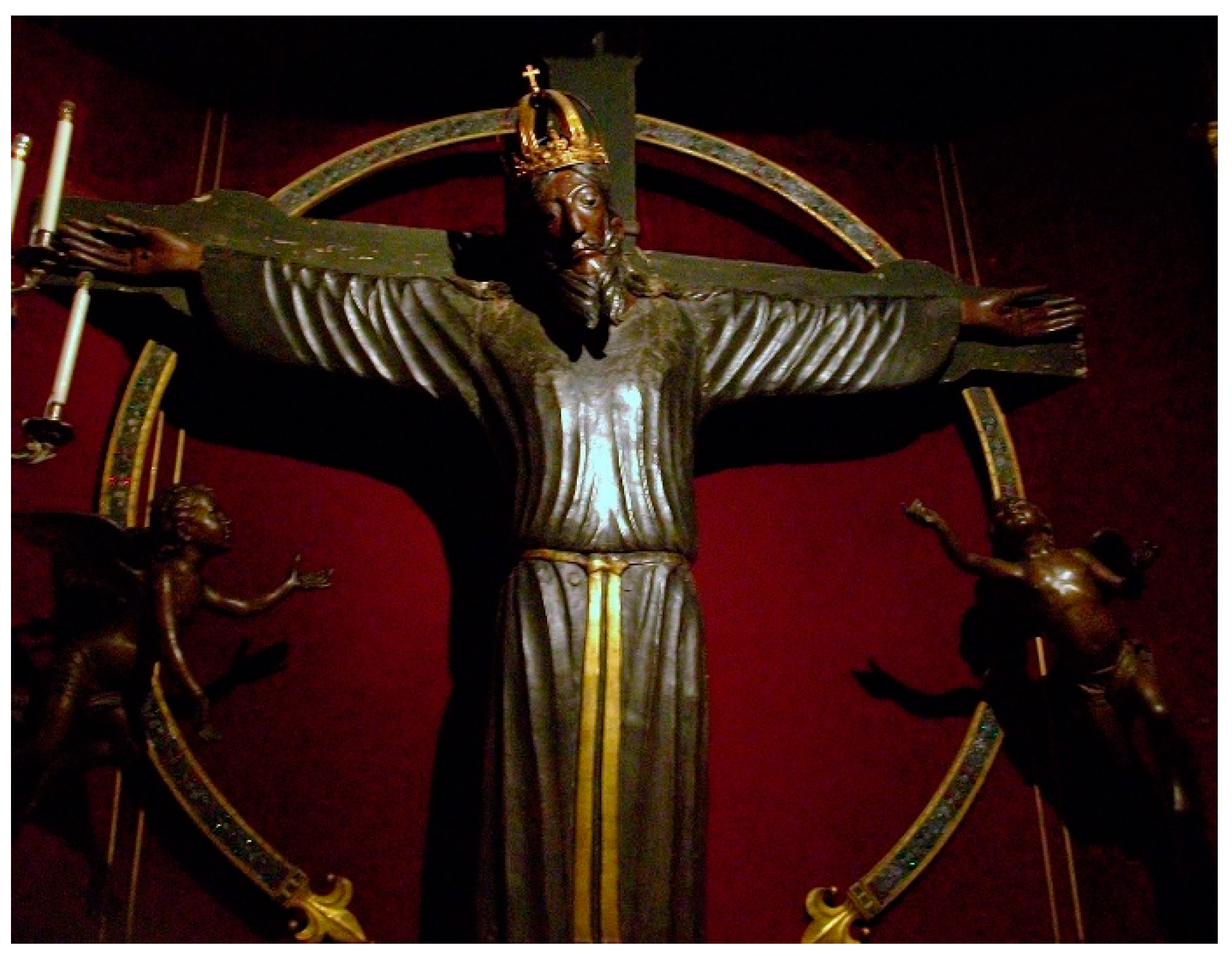
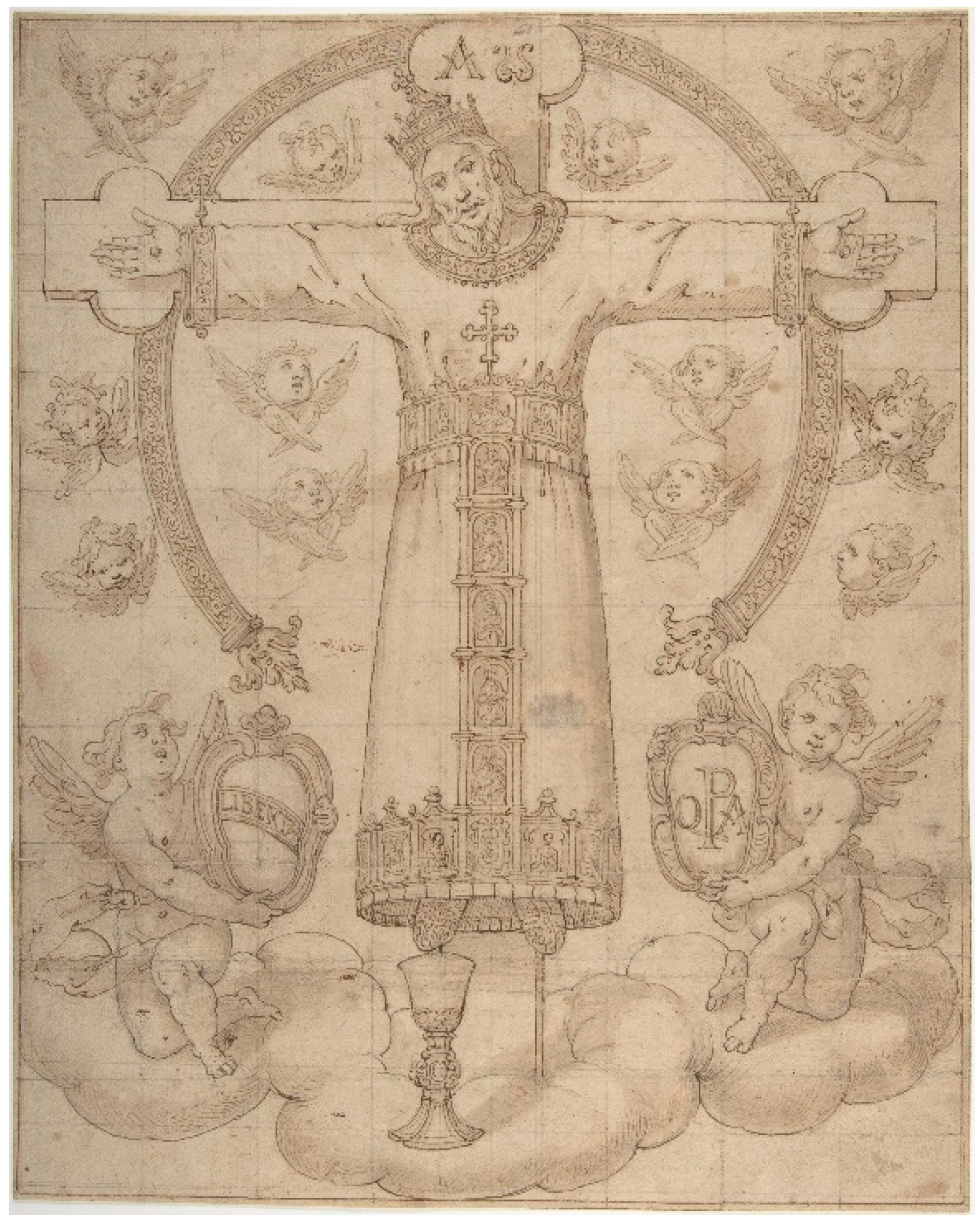
© 2019 by the author. Licensee MDPI, Basel, Switzerland. This article is an open access article distributed under the terms and conditions of the Creative Commons Attribution (CC BY) license (http://creativecommons.org/licenses/by/4.0/).
Share and Cite
Bø, R.M. Sculptures and Accessories: Domestic Piety in the Norwegian Parish around 1300. Religions 2019, 10, 640. https://doi.org/10.3390/rel10110640
Bø RM. Sculptures and Accessories: Domestic Piety in the Norwegian Parish around 1300. Religions. 2019; 10(11):640. https://doi.org/10.3390/rel10110640
Chicago/Turabian StyleBø, Ragnhild M. 2019. "Sculptures and Accessories: Domestic Piety in the Norwegian Parish around 1300" Religions 10, no. 11: 640. https://doi.org/10.3390/rel10110640
APA StyleBø, R. M. (2019). Sculptures and Accessories: Domestic Piety in the Norwegian Parish around 1300. Religions, 10(11), 640. https://doi.org/10.3390/rel10110640




